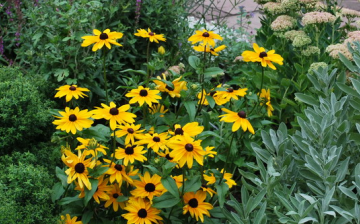Rudbeckia varieties and agricultural technology
The main feature of rudbecky is late flowering, from the end of July to the very frost. In addition, rudbeckia, whose varieties are unpretentious, perfectly tolerates rather severe winters without requiring shelter.
The homeland of rudbeckia, like many other flowers, vegetables and berries, is North America. There are about 30 varieties of annual and perennial rudbeckies, from which breeders have obtained a huge number of hybrids.
Garden rudbeckia - plants, up to one and a half meters tall, with straight, strong stems, branched, covered with fine stiff hairs, leaves are oval, whole or feathery. Rudbeckia, the varieties of which are large, have inflorescences-baskets up to 17 cm in size. Fruits - achenes contain very small tubular seeds, the number of which in 1 g is more than 1.5 thousand.
Annual varieties of rudbeky are propagated by seeds, perennials - by dividing the bush and rosettes of leaves.
Rudbeckia is a thermophilic plant, tolerates heat and drought well, is not too demanding on the composition of the soil, preferring a well-loosened lawn, with a sufficient amount of humus, loves watering.
Rudbeckia is sown for seedlings in April, flowers will be ready for planting in open ground in 30-40 days. However, you can sow a flower immediately in open ground, in June, but then it will be possible to get flowering only in the second year.
Rudbeckia care includes watering, weeding, loosening and periodic feeding. Withering inflorescences must be removed to a good leaf. In autumn, perennial rudbeckia is cut to the very root. After three years, perennials begin to lose their decorative effect, so they need to be updated by removing all the shoots.




I have such flowers growing under the windows, but almost no one even looks after them. It can be seen that either the land is suitable for them, or the plant itself is unpretentious.